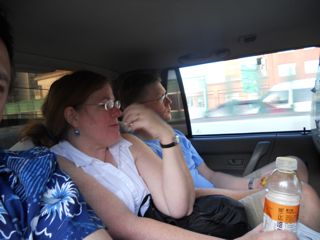 Chinese people, as a general rule, have dark hair. As a race of people, they also tend to not be quite as tall as some other races of people. And you could be forgiven for thinking that most Chinese people adhere to fairly strict diets because they tend to be fairly slim in build.
Chinese people, as a general rule, have dark hair. As a race of people, they also tend to not be quite as tall as some other races of people. And you could be forgiven for thinking that most Chinese people adhere to fairly strict diets because they tend to be fairly slim in build.
Now before you accuse me of making racist remarks, I’m simply making an observation on what I’ve seen. And apparently the Chinese people themselves would concur with these observations because whenever they see a westerner (or “big nose” as they call us) who is tall, heavily built or has non-black hair, they tend to stare and talk. Because I’m fairly tall, in some cases I even had some of the Shanghai locals come up and ask to have their photo taken with me, such is their interest in these strange “big nose” visitors.
So you can imagine the attention we drew when myself, Wes Fryer, Gail Lovely and Melinda Alford decided to spend a day of sightseeing in Suzhou, (苏州市) a city to the west of Shanghai. Wes is as tall as I am, but with blonde hair. Gail has hair that is blonde bordering on redhead. And Melinda has a wild shock of long dark hair and a stocky frame. Together as a group, we must have looked like a travelling freak show.
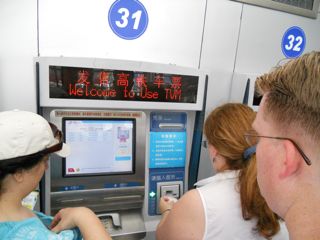 Our day started with a taxi ride from Pudong to Puxi and the local railway station. The railway station was amazing… more like an airport. People were lined up to buy tickets at the many vending machines outside the terminal, and you do need to specify exactly what train you plan to catch as all seating is allocated. Once a train is full you can’t get a seat.
Our day started with a taxi ride from Pudong to Puxi and the local railway station. The railway station was amazing… more like an airport. People were lined up to buy tickets at the many vending machines outside the terminal, and you do need to specify exactly what train you plan to catch as all seating is allocated. Once a train is full you can’t get a seat.
The trains themselves are high speed, and we got one of the brand new G-series trains that covers the 120km (75 miles) from Shanghai to Suzhou in a mere 25 minutes. At one point we clocked our speed at over 270km/h. I don’t think any of us realised just how fast we were going until we got off the train at Suzhou station and another train went through on a different line. It was a bit of a blur!
Once out of the massive Suzhou railway station, Melinda, who speaks some Chinese, managed to do some negotiations with a local driver to transport us around for the day. For a very small fee he was to be our guide (well, our driver… with little English, he didn’t really say a lot!) and take us around to some of the sights of the city. To be honest, we had no idea where he would be taking us, but we just trusted him to do it.
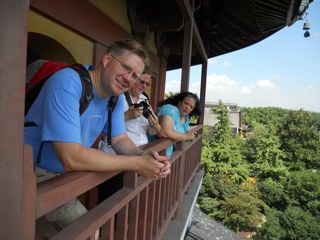 As it turns out, I thought we got a great snapshot into some of the sights of Suzhou. We started out at the Beisi Pagoda, a 9-story temple with a history that goes back some 1700 years. Wes and I climbed to the very top for photos and to marvel at the view.
As it turns out, I thought we got a great snapshot into some of the sights of Suzhou. We started out at the Beisi Pagoda, a 9-story temple with a history that goes back some 1700 years. Wes and I climbed to the very top for photos and to marvel at the view.
We then visited a silk factory. China is known for its silk production and Suzhou was one of the main cities on the famous Silk Road. It was interesting to see how they spin the silk into threads, quite literally just unravelling the silkworm cocoon and using machinery to spin the very fine silk threads into a fibre. They also used some interesting techniques that stretched the cocoons over a bamboo frame to produce a silk web that was then stretched out over a bed-sized frame in layers to produce a silk blanket. Of course, no visit to any sort of factory such as this would be complete without exiting via the giftshop! I started to video inside the giftshop but was very quickly told to turn off the camera because it was not allowed. At first I thought that was odd until I realised how many products they had that used Disney characters… I’m guessing that they aren’t paying Disney a whole lot of licensing fees for the use of Donald and Mickey?
By the way, as we entered the silk factory a little Chinese guy with no real English came up to me and started pointing at my arms and touching them… I think he was making comment on my height and build, implying that I had big arms (I don’t think I do, but he seemed to think so) and this was fairly typical of the sort of attention that our little “gang of four” got as we traveled around.
 Our driver decided that he would do a little “side job” while we in the silk factory, so we went and had lunch while we waiting for him. We found a fast food noodle and dumpling place where Melinda placed an order in Chinese (thank goodness we had Melinda with us… this would have all been so much harder otherwise!) and we soon has a fast food feast on the table. It was kind of funny, because the food was all soups and dumplings and noodles, but the store felt exactly like a McDonalds or KFC. The menus were all in Chinese of course.
Our driver decided that he would do a little “side job” while we in the silk factory, so we went and had lunch while we waiting for him. We found a fast food noodle and dumpling place where Melinda placed an order in Chinese (thank goodness we had Melinda with us… this would have all been so much harder otherwise!) and we soon has a fast food feast on the table. It was kind of funny, because the food was all soups and dumplings and noodles, but the store felt exactly like a McDonalds or KFC. The menus were all in Chinese of course.
After lunch we kept touring around, getting plenty of sideways glanced from the locals who seemed to think that we were a bit of a novelty. Our driver picked us up and took us down by the river where we struck a deal with a barge owner to take us into the water city. It was a bit of a highlight of the day, as we had our own private barge to show us the city from the water. Melinda said she’d been to the city many times but always on foot, and thought that seeing it from the water was the way to go. It would have been nice to get off the barge at some point and go exploring a little, but instead we navigated our way into the central part of the canal system before turning around and going back to our waiting driver. We all laughed when our boat captain got on the phone and rang our driver to ask (translated thanks to Melinda) “Where are you? I’ve got your Big Noses here”.
To finish our day, we went to a silk embroidery factory and saw some silk artwork being made. Our guide was very informative, with quite good English, and he explained the finer points of silk embroidery… it’s quite an artform!
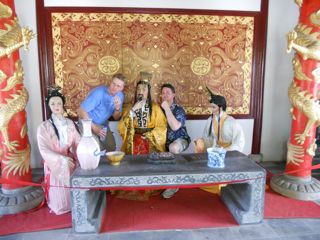 After that we visited a lovely traditional Chinese garden. Well, I guess it was kind of traditional if you don’t count the animatronic figures in the displays! Some of them were pretty funny. Overall though, the gardens were very nice and we all went for a walk up and down the river, taking photos and talking.
After that we visited a lovely traditional Chinese garden. Well, I guess it was kind of traditional if you don’t count the animatronic figures in the displays! Some of them were pretty funny. Overall though, the gardens were very nice and we all went for a walk up and down the river, taking photos and talking.
Back at the railway station waiting for our train, we were still getting checked out by the locals. People would sit in bemusement as we walked past, not quite sure what to make of the four of us. We certainly stood out. As we waited, Wes started working on a digital story project using a terrific little iPhone app called Storykit, while I let some little Chinese kids play Fruit Ninja on my iPhone.
The trip back to Shanghai was quick and we grabbed a taxi back to Pudong, where we had dinner in an American-style cafe. There was lots of laughing and fun as we shared a few drinks, reflected on our day, and unsuccessfully tried to demonstrate the robustness of Chinese paper money. We finished off our day with a bit of shopping at the local Best Buy, before grabbing a taxi back to our hotel.
Overall, a great day shared with great folk. Let’s do it again sometime…
Fullsize photos on Flickr at http://www.flickr.com/photos/betchaboy/sets/72157624864632311/

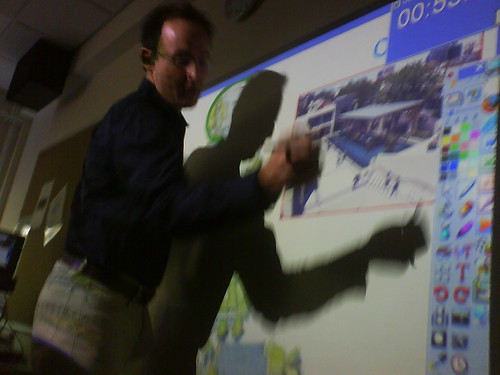 You may have noticed that it’s been a bit quiet here on the blog lately. I’ve not been writing here as much as usual and I’ve really missed it!
You may have noticed that it’s been a bit quiet here on the blog lately. I’ve not been writing here as much as usual and I’ve really missed it!